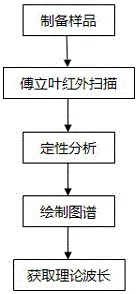Method for distinguishing infrared radiation absorption characteristics of cereals and pests
A technology of infrared radiation and absorption characteristics, applied in measuring devices, material analysis through optical means, instruments, etc., can solve the problem of high energy consumption of infrared equipment, unclear essential connection, and no systematic research on infrared radiation parameters. and other problems, to achieve the effect of low energy consumption, small change in grain quality, and high insecticidal efficiency
- Summary
- Abstract
- Description
- Claims
- Application Information
AI Technical Summary
Problems solved by technology
Method used
Image
Examples
Embodiment 1
[0023] Example 1 Infrared Spectral Detection of Corn Elephant and High Moisture Rice
[0024] 1. Obtain higher moisture rice
[0025] Paddy with an initial moisture content of 15±0.3% was adjusted to target moisture content of 15%, 18%, 21% and 24% with deionized water.
[0026] 2. Culture of maize elephants
[0027] Put adult corn weevils into uninfected rice, place them in an artificial climate incubator with a temperature of 28°C and a relative humidity of 70%, pick out the adults after incubation for 6-7 days, and cultivate the infected rice for about 30 days to find Signs of activity of adults. During the cultivation period, no larvae and pupae of corn weevil were found with the naked eye. They need to be stained with acid fuchsin, lightly crushed and observed under a dissecting microscope, but this is not conducive to the research of this experiment, so only the adult state of corn weevil was used experiment.
[0028] 3. Collection and Handling of Corn Weevil Adults ...
Embodiment 2
[0034] Example 2 Infrared Spectrum Detection of Adults of Tribulus chinensis and High Moisture Rice
[0035] 1. Obtain higher moisture rice
[0036] Paddy with an initial moisture content of 15±0.3% was adjusted to target moisture content of 15%, 18%, 21% and 24% with deionized water.
[0037] 2. Cultivation of Trichosmus chinensis
[0038] Put the eclosioned adult worms into uninfected rice, place them in an artificial climate incubator with a temperature of 25°C and a relative humidity of 60%, and pick out the adults after incubation for 4-8 days, and cultivate the rice that has been infected with eggs Larvae can be observed around 20 days, larvae hatch into pupae after 6 days, and activity signs of adults can be found after 35 days.
[0039] 3. Collection and processing of the different morphs of Tribulus chinensis
[0040] The larvae, pupae, and adults of Tribulus chinensis were selected from each stage. In order to facilitate the test, the selected pests were placed in...
Embodiment 3
[0045] Example 3 Infrared Spectral Detection of Grain Beetle and High Moisture Rice
[0046] 1. Obtain higher moisture rice
[0047] Paddy with an initial moisture content of 15±0.3% was adjusted to target moisture content of 15%, 18%, 21% and 24% with deionized water.
[0048] 2. Cultivation of Grain Beetle
[0049] Put the adult beetles after eclosion into uninfected rice, place them in an artificial climate incubator with a temperature of 30°C and a relative humidity of 80%, pick out the adults after incubation for 10-15 days, and culture the rice with eggs infected for 40 days Signs of activity of adults can be found on the left and right. During the culture period, no larvae and pupae of the beetle could be found with the naked eye. They need to be stained with acid fuchsin, lightly crushed and observed under a dissecting microscope, but this is not conducive to the research of this experiment, so only the adult state of the beetle was used for the study. experiment. ...
PUM
 Login to View More
Login to View More Abstract
Description
Claims
Application Information
 Login to View More
Login to View More - R&D
- Intellectual Property
- Life Sciences
- Materials
- Tech Scout
- Unparalleled Data Quality
- Higher Quality Content
- 60% Fewer Hallucinations
Browse by: Latest US Patents, China's latest patents, Technical Efficacy Thesaurus, Application Domain, Technology Topic, Popular Technical Reports.
© 2025 PatSnap. All rights reserved.Legal|Privacy policy|Modern Slavery Act Transparency Statement|Sitemap|About US| Contact US: help@patsnap.com



